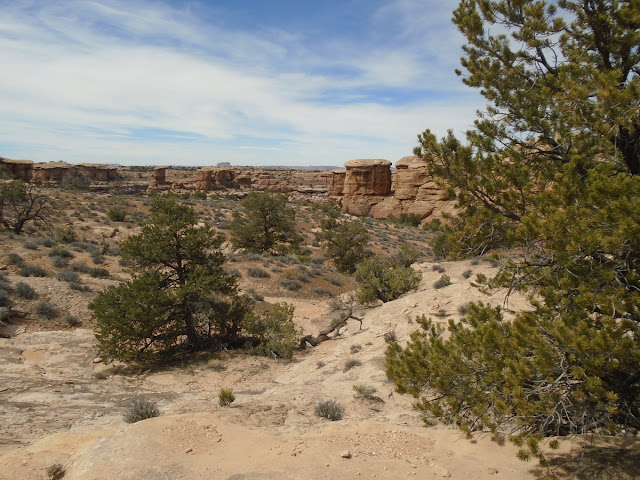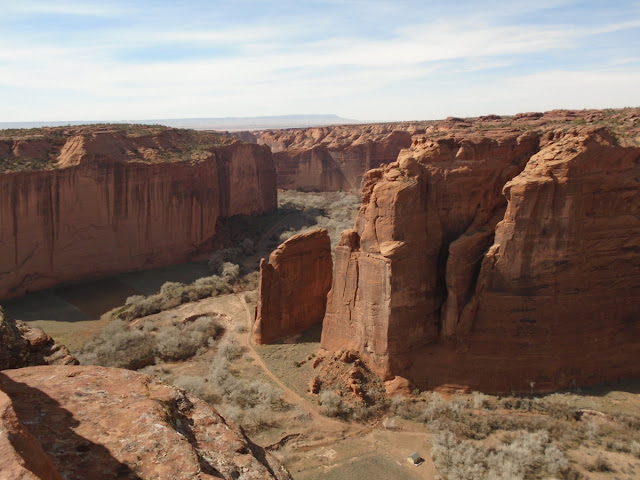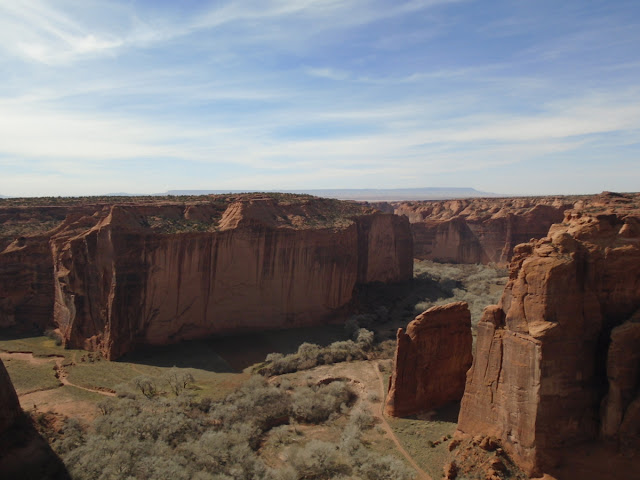It is a cool, crisp morning here in Blanding, Utah, where we spent the night. We'll soon be on our way to nearby Canyonlands NP. ~~~~~~~~~~~~~~~~~~~~

Once we had climbed out of the canyon
again and had passed the (obvioulsy very tourist-oriented) town of
Show-Low the landscape reverted more and more to the dry, sandy
plains we have traversed often here in the southwest. Petrified
Forest NP is part of this landscape where erosion has shaped not only
the badland mesas and valleys but has also exposed the petrified
trees this park is named for, as well as many other fossils, and
continues to do so.
When we turned off the highway we
stopped at the visitor centre for some information and a map and soon
found that this was not the NP visitor centre but one administered by
the Navajo Nation. The park is part of their lands. We admired some
of the pricey artwork created from petrified wood, among others a
huge block that weighed 28,000 lbs.
It is not surprising that security is
tight in this park: thefts have occurred, though not as widespread
and damaging as rumoured. Shortly after we passed the entry gate
flashing lights indicated a road control: we were asked if we could
answer a few questions regarding our experience at the gate with the
ranger admitting us. I'm not sure what this was about; is there a
constant review of these park employees to make sure that they don't
aid in possible theft?
Armed with the official map of the park
and some tips where best to spend the 2 1/2 hours we had left until
the park closed at five (we didn't know this before we came) we were
on our way to the first stop.
“Crystal Forest” is probably the
area with the most concentrated incidence of petrified logs in the
park. Trails connected with the different view points are paved and
thus easy to walk, and this one was just over a kilometre long. It is
strange and beautiful to see these crystallized logs scattered all
over, to think that all of these were once trees, most of them of
tropical origin. During the Triassic Period all of this land resided
on the supercontinent Pangea, at about the latitude of present-day
Costa Rica. When Pangea broke apart, the North American continent
moved northward, and over the next several millions of years the
Colorado Plateau lifted up by about a mile. This is the reason why it
is so arid here now.
This area was once at the edge of a
river channel. Fallen trees crisscrossed the channel and some of the
adjacent floodplain. Periodic flooding buried some of these trees
under layers of silt. Over time, silica-enriched groundwater
percolated through the logs and replaced the organic material,
creating a replica in quartz. Erosion continued, exposing the now
petrified logs. The colours of these logs are of an amazing variety,
ranging from white over grey to red, with all kinds of hues in
between. This is due to impurities in the quartz: red, orange, yellow
and purple indicate iron oxides, black and grey manganese oxides, and
white is pure quartz. (I garnered all of these facts from the
signs in Crystal Forest)
Following the
rangers recommendations we next stopped at Blue Mesa, an area not
unlike our Alberta badlands near Drumheller, where we walked the
mile-long paved trail.
The last stop,
shortly before leaving the park again, was at the northern end, aptly
called Painted Desert. The late afternoon light was especially
advantageous to view it, though it would have been even more
impressive closer to sunset. Since the park closes at five, however,
we didn't get to wait that long.
I-40 took us to our
night's destination at Chambers, the starting point for yesterday's
visit to Canyon de Chelly – which I will talk about after our day's
adventures at Canyonlands NP.



















































